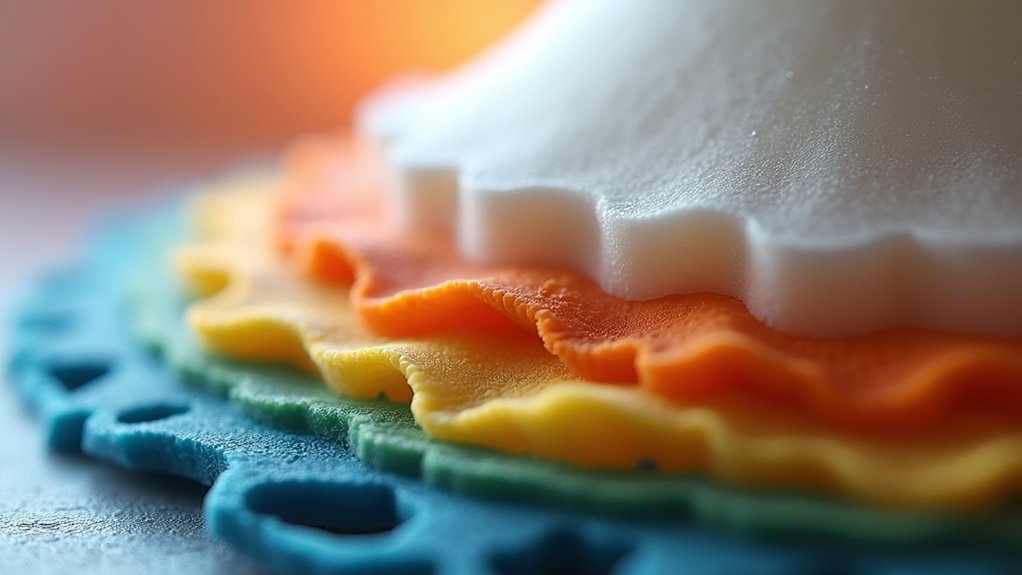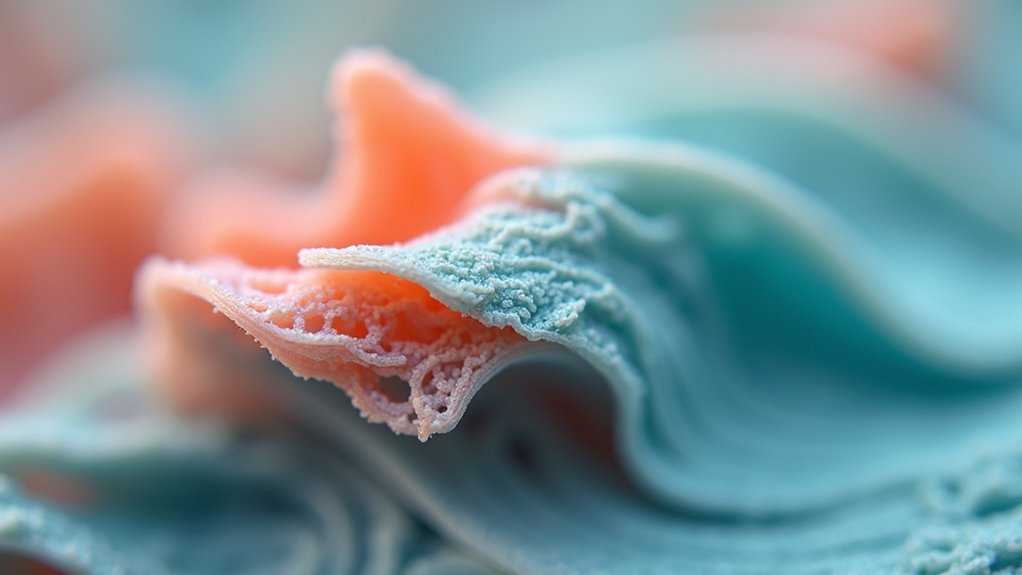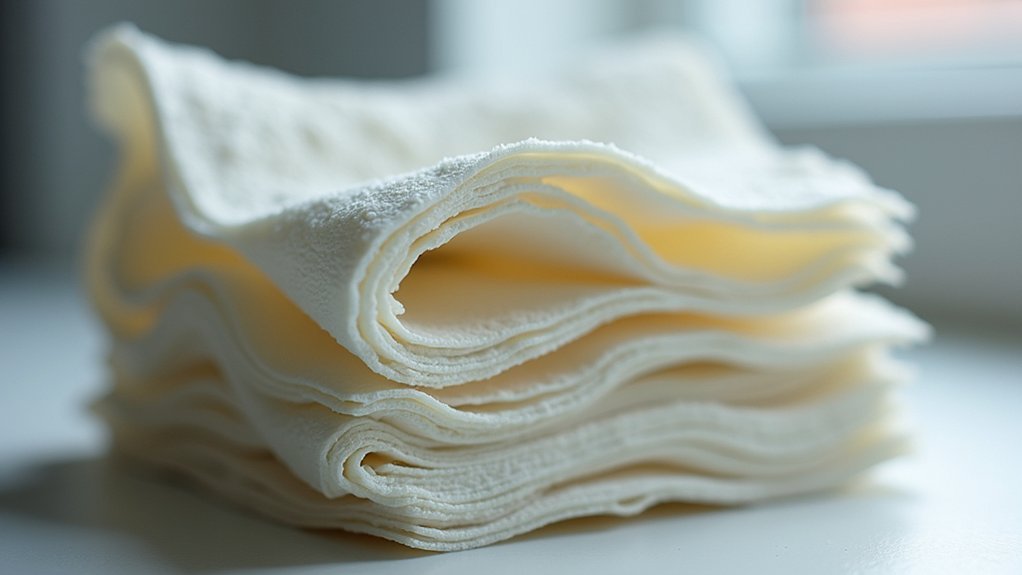When your extruder temperature runs too low, you’ll experience weak layer bonds that cause visible separation lines and delamination in your prints. Insufficient heat prevents proper filament melting, resulting in matte surface textures, horizontal cracks, and stringy prints with voids. For PLA, you’ll need temperatures between 200°C-230°C for ideal adhesion, while PETG requires 215°C-230°C. Running below these ranges can reduce print strength considerably, with samples failing at just 20 MPa. Understanding these temperature relationships helps you achieve stronger, more durable prints.
Understanding the Relationship Between Temperature and Layer Bonding

When your extruder temperature drops below ideal levels, the filament doesn’t melt completely, creating weak bonds between successive layers that can compromise your print’s structural integrity.
This temperature-dependent relationship directly affects how well each layer fuses with the one below it.
Your PLA filament requires temperatures between 200°C to 230°C for peak layer adhesion.
When you print at insufficient temperatures like 190°C, you’ll notice significant strength reduction – samples can fail at just 20 MPa compared to properly heated prints.
The insufficient melting prevents proper material flow, resulting in visible layer separation and a matte surface finish.
Increasing your Extrusion Temperature by 5-25°C improves filament melting consistency, enhancing interlayer bonding and preventing delamination that weakens your final print.
Signs Your Extruder Temperature Is Too Low
Recognizing the warning signs of inadequate extruder temperature helps you troubleshoot print quality issues before they ruin your project.
When your temperature settings fall below ideal ranges, you’ll notice several telltale indicators that signal poor thermal conditions during extrusion.
Key visual signs include:
- Matte surface texture – This indicates insufficient melting and poor layer fusion, creating a dull finish instead of the expected smooth appearance.
- Horizontal cracks or delamination – These structural failures occur when inadequate heat prevents proper adhesion between layers, compromising print integrity.
- Stringy prints with visible voids – Under-extrusion creates gaps and weak points throughout your model, greatly degrading overall quality.
Temperature adjustments can prevent these issues and restore proper layer bonding for stronger, higher-quality prints.
How Under-Extrusion Leads to Weak Layer Adhesion

Although proper filament melting requires adequate heat, under-extrusion occurs when your nozzle temperature drops too low to fully liquify the material during printing. This insufficient melting prevents adequate filament flow, creating weak spots between layers that compromise your print’s structural integrity.
When you’re experiencing under-extrusion, the partially melted filament can’t properly bond with previous layers. You’ll notice your prints developing a matte texture and visible voids that signal poor inter-layer bonding. These defects directly weaken layer adhesion, making your parts susceptible to delamination and structural failure.
Testing confirms this relationship dramatically affects strength. PLA printed at 190°C can fail at just 20 MPa, while increasing temperature to 200°C improves strength to 37 MPa, demonstrating how proper melting enhances layer adhesion.
Finding the Optimal Temperature Range for Your Filament
How do you determine the precise temperature that transforms your filament from problematic to perfect? You’ll need to systematically test different nozzle temperatures within your filament’s recommended range to achieve ideal adhesion.
Here’s your approach to finding the ideal temperature:
- Print a temperature tower – Test temperatures incrementally across your filament’s range to identify where layer bonding peaks.
- Follow manufacturer guidelines – Start with their recommended ranges: PLA (200-230°C) or PETG (215-245°C).
- Monitor quality indicators – Watch for under-extrusion at low temperatures and stringing at high temperatures.
PLA typically achieves peak strength around 210-230°C, while PETG performs best near 230°C.
You’ll notice poor adhesion and weak layers below ideal ranges, but excessive heat creates surface defects.
Precise temperature control transforms weak prints into strong, properly-bonded layers.
Using Temperature Towers to Diagnose Adhesion Problems

You’ll need to print a temperature tower that tests multiple temperatures in a single print, typically ranging from 190°C to 270°C for PLA or 200°C to 260°C for PETG.
Once your tower’s complete, you can examine each temperature section to identify where layer adhesion improves or degrades.
The key is analyzing how each temperature level affects bonding strength, surface quality, and overall print integrity to pinpoint your filament’s ideal range.
Temperature Tower Design
When troubleshooting layer adhesion problems, temperature towers provide a systematic approach to identify the best extruder temperature for your specific filament.
You’ll design these structured test prints with multiple sections, each printed at different temperatures within your filament’s recommended range.
For effective temperature tower design, follow these steps:
- Set temperature increments – Use 5-10°C steps across your filament’s range (PLA: 190-270°C, PETG: 200-260°C)
- Include geometric features – Add overhangs, bridges, and fine details to test thorough print quality
- Mark each section – Label temperatures clearly for easy identification during analysis
You’ll observe how lower temperatures cause layer separation and poor adhesion between the layers, while higher temperatures may create stringing.
This visual assessment helps you select ideal settings that balance strong layer bonding with quality surface finish.
Interpreting Test Results
After completing your temperature tower print, analyzing the results reveals critical information about your filament’s adhesion characteristics at different temperatures.
You’ll notice distinct differences between temperature segments – lower temperatures like 190°C often show under-extrusion, rough surfaces, and layers that separate easily when stressed. These are clear indicators of bad adhesion that’ll compromise your print’s structural integrity.
At ideal temperatures around 200-230°C for PLA, layers bond properly and surfaces appear smooth.
However, don’t ignore print speed during testing – slower speeds at lower temperatures might mask adhesion problems. Higher temperatures may introduce stringing or surface defects, so you’re balancing adhesion quality against print aesthetics.
Focus on the temperature range where layers bond strongly without excessive defects.
Material-Specific Temperature Requirements for Better Bonding
Different 3D printing materials demand specific temperature ranges to achieve strong interlayer bonding, and understanding these requirements prevents the weak adhesion that plagues many failed prints.
PLA performs best between 190°C and 230°C, with peak layer strength occurring at 200°C to 230°C. PETG requires slightly higher temperatures, ranging from 200°C to 260°C, though the sweet spot for interlayer bonding sits between 215°C and 230°C.
You’ll recognize insufficient temperature through these telltale signs:
- Under-extrusion creating visible gaps between layers
- Matte surface texture indicating poor material flow
- Weak bonds that separate easily under minimal stress
Temperature towers help you identify your material’s best settings. Running these calibration prints eliminates guesswork and makes sure you’re hitting the temperature range that maximizes adhesion for your specific filament brand.
Adjusting Temperature Settings for Different Print Orientations
Print orientation dramatically affects how temperature impacts layer adhesion, requiring you to fine-tune your extruder settings based on whether your model sits flat or stands upright.
Standing prints demand higher temperatures than lying orientations because vertical layers face greater stress and need stronger bonds. At 190°C, standing samples failed at just 20 MPa due to inadequate layer adhesion, while higher temperatures markedly improved strength.
Vertical prints require higher extruder temperatures than horizontal orientations due to increased layer stress and weaker adhesion bonds.
You’ll need to increase your extruder temperature by 5-10°C when printing vertically compared to horizontal orientations.
Use a temperature tower to identify ideal settings for each orientation. Monitor your first few layers closely, as standing prints show adhesion problems more quickly than lying prints, helping you adjust temperature settings before complete print failure.
Balancing Temperature With Other Print Parameters
When you’re dealing with low extruder temperatures, you can’t just focus on heat alone—you’ll need to adjust other print parameters to maintain quality.
Slowing down your print speed gives each layer more time to bond properly, compensating for the reduced thermal energy.
You’ll also want to carefully manage your cooling fan settings, as too much airflow can worsen adhesion problems when you’re already printing at lower temperatures.
Print Speed Adjustments
The delicate dance between print speed and extruder temperature requires careful choreography to achieve ideal layer adhesion. When you’re dealing with low extruder temperatures, reducing your print speed becomes essential for maintaining proper bonding between layers.
You’ll want to maintain speeds between 50–60 mm/s for superior results.
Here’s how to optimize your print speed adjustments:
- Reduce speed incrementally by 5 mm/s when experiencing adhesion problems
- Combine slower speeds with higher extruder temperatures to improve filament flow
- Monitor cooling rates carefully as slower speeds allow better fusion before solidification
This approach gives your filament more time to properly melt and bond with previous layers.
You’ll find that slower cooling between layers at reduced speeds considerably enhances layer adhesion without introducing print defects.
Cooling Fan Settings
Cooling fan management directly impacts how well your layers bond together, making it one of the most critical adjustments when battling low extruder temperature issues. Excessive cooling fan settings create rapid temperature changes that cause warping and layer separation, while insufficient cooling leads to overheating and poor surface quality.
You’ll need to start with reduced fan speeds during initial layers to improve layer adhesion, then gradually increase cooling for subsequent layers. This prevents rapid temperature fluctuations that cause delamination.
| Layer Range | Fan Speed | Purpose |
|---|---|---|
| First 2-3 layers | 0% | Maximize bed adhesion |
| Layers 4-10 | 30% | Gradual temperature control |
| Remaining layers | 30-50% | Balance cooling/bonding |
| Detail areas | Variable | Prevent overheating |
Experimentation helps you find ideal settings for your specific material and print conditions.
Troubleshooting Persistent Layer Separation Issues
Although layer separation might seem like a complex issue, you can systematically identify and fix the underlying temperature problems causing your prints to delaminate.
Layer separation appears complex but systematic troubleshooting can identify and resolve the temperature issues causing print delamination.
When your PLA prints show visible cracks and matte textures between layers, you’re likely dealing with insufficient melting at low temperatures.
Follow this troubleshooting approach:
- Incrementally increase temperature – Raise your extruder temperature by 5-10 degrees within PLA’s ideal 200°C-230°C range until layer fusion improves.
- Inspect your print head – Make sure the nozzle isn’t clogged, as blockages worsen under-extrusion and compound adhesion problems.
- Test layer bonding – Print small test pieces to verify that interlayer bonds strengthen as you adjust temperature settings.
Regular nozzle maintenance prevents clogs that exacerbate these temperature-related separation issues.
Frequently Asked Questions
What Causes Poor Layer Adhesion?
Poor layer adhesion happens when you’re printing at temperatures too low for your filament, causing insufficient melting and weak bonding between layers, or when you’ve got incorrect bed leveling affecting first layer adhesion.
What Temperature Is Good for PLA Layer Adhesion?
You’ll get ideal PLA layer adhesion printing between 200°C and 230°C, with 210°C being most effective. Use a temperature tower to fine-tune your specific filament’s requirements for best results.
Does Nozzle Temperature Affect Bed Adhesion?
Yes, nozzle temperature directly affects bed adhesion. If you’re using too low temperatures, your filament won’t melt properly, creating weak bonds between your first layer and print bed surface.
What Temperature Should ABS Layer Adhesion Be?
You should set your ABS nozzle temperature between 220°C and 250°C for ideal layer adhesion. Many users find 240°C works particularly well. Adjust gradually in 5-10°C increments if you’re experiencing adhesion issues.





Leave a Reply